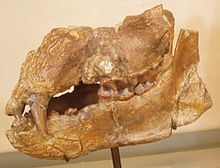- Hemicyonidae
-
Hemicyonidae
Temporal range: Early Miocene to Pliocene
22–2 MaHemicyon sansaniensis Scientific classification Kingdom: Animalia Phylum: Chordata Class: Mammalia Order: Carnivora Suborder: Caniformia Family: †Hemicyonidae Genera - †Agriotherium
- †Dinocyon
- †Hemicyon
- †Phoberocyon
- †Plithocyon
- †Zaragocyon
Hemicyonidae is an extinct family of so-called "dog-bears", literally "Half Dog" (Greek: ἡμικυων "hemi-kuôn"), bear-like carnivoran living in Europe, North America, Africa, and Asia during the Oligocene through Miocene epochs 33.9—5.3 Ma, existing for approximately 28.6 million years.
Contents
Morphology
They were about 1.50 m (5 ft) long, 70 centimetres (28 inches) tall, with somewhat tiger-like proportions and dog-like teeth, weighing as much as 69 kg (150 lb).
Hemicyonids are widely accepted to have been hypercarnivorous and highly predaceous. They walked on their toes, i.e., they were digitigrade, with long metapodials. In these respects they were similar to dogs, and unlike modern bears, which are plantigrade with short metapodials. This suggests that hemicyonids must have been active hunters and good runners, and presumably hunted on the plains, possibly in packs. Note that the hemicyonids are easily confused with the related and often similar-looking "bear-dogs" of the family Amphicyonidae.
Taxonomy
Classification of the hemicyonids has become complicated. Some classifications subdivide the Hemicyonidae into two subfamilies: Phoberocyoninae (including Phoberocyon and Plithocyon) and Hemicyoninae (including Zaragocyon, Hemicyon, and Dinocyon). The earliest known occurrence of the hemicyonids is in Europe from 22.8–20 Ma of Spain: Phoberocyon hispanicus from Loranca and Zaragocyon daamsi from Cetina de Aragon.
Genus identification
Hemicyonids lived continuously in Europe with the oldest known being Cephalogale existing from ~33.9—20 Ma. In North America specimens have been uncovered which date from ~21.6—21.2 Ma.[1] Phoberocyon johnhenryi is yet another old specimen from the large Thomas Farm Site, Florida, (~19–18 Ma). This species of the genus Phoberocyon is confirmed by diagnostic features of the lower dentition: posterior accessory cusps in lower premolars and paraconid in m2, and it is a more derived species than Phoberocyon hispanicus in that it is larger and has diastemata between the premolars.
All the American hemicyonids are more advanced in character, and are assigned to genus Plithocyon. They are known from the Barstovian of California, New Mexico, Nebraska, Wyoming and the Love Bone Bed Local Fauna in Florida. In Asia, the earliest hemicyonid is Phoberocyon youngi from Shanwang, Shandong (16 Ma) and is very close to the North American Phoberocyon johnhenry. The latest occurrence in China is from the Tung-Gur Formation, Nei-Mongol (13 Ma). Dispersal probably occurred from Europe to North America prior to 19 Ma and the American Plithocyon is probably a descendant of the Phoberocyon.
The genus Agriotherium is sometimes considered a member of Hemicyonidae due to the presence of many similar hemicyonine characters (unelongated molars, premasseteric fossa, etc.) and this strongly substantiates its closer affinity with hemicyonines rather than with ursines. Agriotherium has its longest history in Asia. The most primitive and earliest form is from a Hipparion fauna in Hezheng, Gansu, 9 Ma. All other forms of Agriotherium occurred in the Pliocene (5.3 to 2 Ma) in Eurasia and Africa, leaving a hiatus in the record between 9 and 5.3 Ma. In North America, Agriotherium appeared suddenly around 7 Ma and probably emigrated from Eurasia. Agriotherium fossils have been found at Coffee Ranch, Texas (6.6 Ma); Guymon Local Fauna, Oklahoma; Mount Eden Local Fauna, California; and Old Cabin Quarry, Quiburis Formation (late Hemphillian), Arizona. The occurrence of Agriotherium in North and Central America is thus limited to the later half of the Hemphillian (7–5 Ma).[2]
Hemicyonidae fossil evidence may also have been found in the Gaillard Cut Local Fauna, former Panama Canal Zone, Republic of Panama, but it is indeterminant with Amphicyonidae. Despite its close proximity to South America, given the geological context, the Gaillard Cut Local Fauna are distinctly North American fauna and the age of this assemblage is dated between 19.5 and 14 Ma.[3]
See also
References
- ^ Qiu, Zhanxiang, p. 21
- ^ Qiu Zhanziang (2006). "Dispersals of Neogene Carnivorans between Asia and North America". Bulletin American Museum of Natural History (279): 720–734. http://digitallibrary.amnh.org/dspace/bitstream/2246/447/25/B279a02.pdf.
- ^ MacFadden, Bruce J. (2006). "North American Miocene Land Mammals from Panama". Journal of Vertebrate Paleontology 26 (3): 720–734. doi:10.1671/0272-4634(2006)26[720:NAMLMF]2.0.CO;2. http://www.vertpaleo.org/publications/jvp/26-720-734.cfm.
Categories:- Hemicyonids
- Oligocene mammals
- Miocene mammals
Wikimedia Foundation. 2010.


